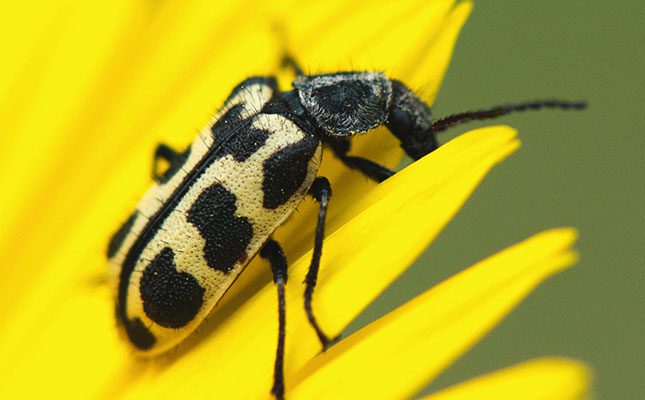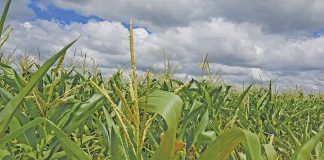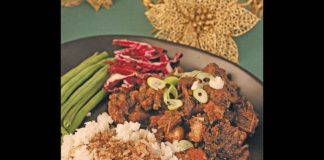
Photo: Wikimedia Commons
Modern-day farming experiences immense pressure to provide the necessary food resources demanded by the growing populace.
This pressure has ignited renewed attention to agricultural practices that promote food production in an environmentally friendly and sustainable manner.
However, farmers are challenged by climate change, which not only has a major impact on the success of crop production but also influences the management of agricultural pests.
Increasing temperatures directly affect a pest’s ability to reproduce, survive, spread and establish.
While chemical control may have been a farmer’s first response in the past, insecticide resistance has led farmers to shift to more holistic farming practices, better known as integrated pest management (IPM).
What is integrated pest management?
IPM is an environmentally friendly approach to pest management. The concept is often misunderstood as a simple combination of different pest control strategies but it is much more complex since it is knowledge-intensive and an understanding is needed of the effects of prevention decisions on subsequent control measures, whether it be chemically, culturally, biologically or manually.
IPM is a decision support system implemented with the use of current, comprehensive information on the life cycles of pests and their interaction with the environment.
Simply put, it is going back to the basic building blocks of farming and, better yet, understanding that production is not only influenced by the environment, but also the practices that influence the beneficial organisms in these systems.
IPM is based on four pillars, namely cultural control, biological control, chemical control and host plant resistance, which can be implemented in combination to control pests more efficiently over a prolonged period.
Cultural control refers to practices that make the environment less attractive to pests and less favourable for their survival, dispersal, growth and reproduction. It is more favourable to the pest’s natural enemies.
Strategies that may be implemented are: (1) modifications to the physical environment with abiotic variables, physical barriers and mulches; (2) agronomic practices like crop rotation, tillage practices, sowing/planting density, fertiliser applications, irrigation schedules, management of natural habitats and weed removal; (3) mixed- and intercropping with push-pull systems and trap cropping.
Biological control uses one organism to control another. This can occur naturally, by means of a natural enemy being introduced into a geographical area where there is a pest problem, or through the release of mass-reared populations of natural enemies.
Conservation biological control is popular among the regenerative agriculture community as conservation of a natural habitat can lead to the reduction of pest numbers.
Chemical control is the use of pesticides to keep the pest populations below economically damaging levels when they cannot be controlled by other means.
Pesticides should only be applied when monitoring information suggests they are required in accordance with set standards, and treatments should only be done with the intention of eliminating only the target organism.
READ Have you considered these farming risks?
Host plant resistance is the collective heritable characteristics by which a plant species, race, clone or individual may reduce the possibility of successful utilisation of that plant as a host by an insect species, race, biotype or individual.
Changes in characteristics that make plants less attractive for feeding, oviposition and establishment include: change in colour, thickening of cell walls and plant tissue, waxy surfaces, and the development of trichomes (hairs).
Using IPM strategies reduces risks to human health as well as to beneficial and non-target organisms and the environment.
| What is the difference between standard pest control and IPM? | |
| Standard pest control | Integrated pest management |
|
|
Why should IPM be adopted on farms?
Prevention is better than cure. Farmers are advised to implement IPM because of its effective pest management capabilities.
IPM effectively manages pest populations while reducing the likelihood of pesticide resistance evolution through the reduced use of pesticides and increased use of alternative control strategies.
As technology advances and scientific knowledge increases, a growing number of traditional chemical insecticide classes are not only being discovered to be dangerous to human health and the environment, but are becoming ineffective at controlling pests.
Insecticide resistance is probably the greatest contributor to inefficient pest control, seeing that pests evolve and adapt to become less susceptible to the specific insecticides, rendering these chemicals ineffective in controlling pest populations. Numerous factors contribute to the development of insecticide resistance.
For example, genetic variation (individuals within a population that possess genetic traits that make them less susceptible to insecticide applications), mutations (spontaneous modifications of genes within a pest population, producing resistance to insecticides with a specific mode of action and passed on to the following generation), cross-resistance (when insects that are resistant to a specific insecticide have resistance to other insecticides with a similar mode of action).
More so, human-driven factors commonly overlooked are farmers’ inappropriate and excessive use of insecticides by applying higher-than-recommended dosages, using insecticides too frequently and not rotating the modes of action, and lack of monitoring of pest populations.
When traditional chemical spraying programmes are followed, ecological niches remain accessible and the same pest that was targeted may occupy these niches in subsequent seasons. Furthermore, secondary pests may develop if pesticides are used inappropriately.
As a result, standard chemical pesticide regimens see year-over-year efficacy declines along with a consistent annual increase in the costs of chemical control.
For this reason, farmers are becoming more aware of the necessity to manage pests in their environment so that their population size is kept below a threshold level without affecting people or non-target animals that coexist in the agricultural setting.
IPM allows farmers to implement a suite of control measures, all of which target the same pest from a variety of angles intended to keep pest population levels below the threshold at which damage occurs. Once a pest population surpasses accepted threshold levels, insect predators, parasitoids (natural enemies), or entomopathogenic (insect-killing) fungi, bacteria, or nematodes should be introduced.
The use of such organisms is gaining popularity in close production systems such as greenhouses and net houses. When these measures are used alongside chemical sprays, some of which are organic, the pest is attacked from a number of angles simultaneously, reducing population levels in a long-lasting and sustainable way.
The success of an IPM approach to pest control lies in improved crop health and growth, which is crucial for farmers looking at increasing yields and profitability.
What are the key benefits of IPM?
- Environmentally friendly: IPM places a strong emphasis on using environmentally friendly pest control techniques, which lessens the need for dangerous chemicals. It encourages the application of biological, cultural, and mechanical control methods that generally cause less environmental harm.
- Reduced chemical use: IPM significantly reduces the need for pesticide use by incorporating multiple pest control methods. In addition, farmers can delay the evolution of pesticide resistance in pest populations through the rotation of insecticides with different modes of action.
- Cost-effective: Although there might be an initial investment in monitoring equipment and training, the projected cost savings are substantial. IPM’s emphasis on prevention and early intervention makes it cost-effective over the long term. Early identification and management of pests can help prevent extensive harm to crops and minimise costly treatment expenditures. Moreover, the reduced reliance on pesticides means lower input costs.
- Conservation of beneficial organisms: IPM tactics work towards safeguarding and promoting pests’ natural enemies, such as predators, parasitoids and pathogens. As a result, the ecology is brought into balance and natural pest management is aided without the need for potentially hazardous chemicals.
READ The pros of integrated pest management
How to start
The key to successful IPM implementation is understanding that it is not a single pest control method but rather a series of decisions regarding pest management.
IPM-focused farming starts at simple modifications to the day-to-day routine to enhance the benefit that the environment offers.
It is important to remember though that the pros of IPM strategies may only be experienced over a period of time after continuous and consistent implementation efforts.
Generally, farmers follow a tiered approach to include IPM within their daily farming practices. The steps are:
- Prevent
Before taking any pest control action, an action threshold should be considered. This is the point at which the number of a specific pest or the degree of injury to a crop indicates that a control action should be taken. Sighting a single pest individual does not always mean control is needed. - Monitor
Not all insects or weeds require control. Many organisms are innocuous, and most are beneficial. Scouting forms part of this step, because accurate identification and monitoring of pest numbers in the farming area is critically important. This ensures that appropriate control decisions are taken in conjunction with action thresholds. Monitoring limits the possibility that pesticides are used when they are not really needed, or that the wrong pesticide will be used. - Intervene
Once monitoring information indicates that action thresholds have been exceeded, action should be taken to control the pest. Effective, less risky pest controls are chosen first, including highly targeted chemicals such as pheromones to disrupt pest mating, or mechanical control, such as trapping or weeding. If further monitoring, identifications via scouting and action thresholds indicate that less risky controls are not working, then additional pest control methods should be employed, such as targeted spraying of pesticides. Broadcast spraying of non-specific pesticides is a last resort.
In conclusion, IPM is a comprehensive strategy that is consistent with the values of sustainability, environmental stewardship, and ethical farming.
It provides long-term advantages by assuring a more sustainable and environmentally balanced agricultural system, in addition to immediate advantages like cost savings and increased crop yields.
Email Zunel van Eeden at [email protected].










